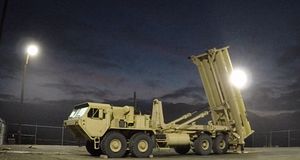On Sunday, Chinese Foreign Minister Wang Yi expressed concern to South Korean Foreign Minister Kang Kyung-wha about Seoul’s decision to proceed with the temporary deployment of additional U.S. Terminal High Altitude Area Defense (THAAD) launchers following North Korea’s launch of an intercontinental-range ballistic missile (ICBM) on July 28. The launchers will be permanently deployed following a still-pending environmental assessment in South Korea.
Wang’s warning came at brief bilateral talks between the two ministers on the sideline of the Association of Southeast Asian Nations (ASEAN) Regional Forum in Manila. “The South Korean government made the decision hurriedly on July 28 to install THAAD [launchers],” Wang said, adding that he thought the decision was “regrettable.”
Responding to Wang’s comments, Kang said that THAAD was a purely defensive system, intended to target North Korea’s ballistic missile threats. “It is true that there are challenges confronting our two nations but those challenges should be resolved through communication,” she added.
The decision to deploy the THAAD system was made under the previous South Korean government, led by President Park Geun-hye before a scandal in late-2016 led to her eventual impeachment and imprisonment. Moon Jae-in, the current president of South Korea, had opposed the THAAD system as an opposition leader but softened his position in early 2017 before running for the presidency in an early election.
The first THAAD launchers were declared operational in South Korea in early May 2017, days before the presidential election. Shortly after his election, Moon decided to delay the deployment of an additional four launchers pending an environmental assessment of the site where the launchers are to be deployed. Moon’s decision came after it emerged that the South Korean military had gone around his office to pursue a full deployment.
China has long been vocal about its opposition to the deployment of THAAD in South Korea, basing its opposition around the powerful X-band AN/TPY-2 radar associated with the battery. Beginning last year, China began unofficially sanctioning South Korean entities on its soil in response to the deployment decision; this included additional scrutiny of operations by South Korea’s Lotte conglomerate, which swapped land with the South Korean government for the system’s deployment.
Beijing’s opposition to THAAD has little to do with the interceptor batteries themselves. Chinese strategists fear that the AN/TPY-2 radar would be able to degrade China’s nuclear second strike capability against the United States by allowing U.S. early warning systems to better discriminate between real and decoy warheads.
Despite the South Korean government’s decision to temporarily deploy additional THAAD batteries after North Korea’s July 28 ICBM launch, THAAD has only been proven to be capable against short-, medium-, and intermediate-range ballistic missile systems. It is not designed to intercept intercontinental-range ballistic missiles and would not be able to intercept a North Korean Hwasong-14 ICBM, the missile tested on July 4 and July 28, 2017.

































